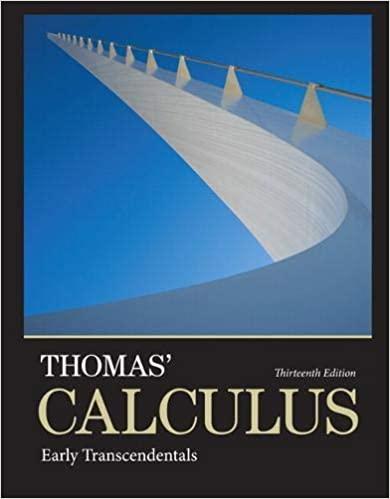Assume that (3) = -1, g(2) = 5, g(2) = 3, and y = (g(x)). What is
Question:
Assume that ƒ′(3) = -1, g′(2) = 5, g(2) = 3, and y = ƒ(g(x)). What is y′ at x = 2?
Fantastic news! We've Found the answer you've been seeking!
Step by Step Answer:
Answer rating: 75% (4 reviews)
Using the chain rule w...View the full answer

Answered By

Prince Kumar
I have teaches last 5 year in difference Colleges and universities. I'm principal in secondary school last 2 year.
0.00
0 Reviews
10+ Question Solved
Related Book For 

Thomas Calculus Early Transcendentals
ISBN: 9780321884077
13th Edition
Authors: Joel R Hass, Christopher E Heil, Maurice D Weir
Question Posted:
Students also viewed these Mathematics questions
-
1. A firm consists of 600 acres of land, of which 500 acres will be planted with corn, soybeans, and wheat according to this condition: -At least half of the planted acreage should be in corn - No...
-
KYC's stock price can go up by 15 percent every year, or down by 10 percent. Both outcomes are equally likely. The risk free rate is 5 percent, and the current stock price of KYC is 100. (a) Price a...
-
Let R be the set of points with 1 x 2 and 0 y 1 and 8(x, y) = x. Find the inertia when R is rotated around the line x = y. (The distance between (a, b) and the line x = y is d = |a-bl/2). The...
-
Aquarius -EAST B Capricornus Horizon Sagittarius SOUTH SUN Scorpius Libra WEST- E Description: If you could see both the Sun and the other stars during the day, this is what the sky would look like...
-
Who do you think would benet more from a "virtual supply chain" capacity strategy-a small start-up firm with few resources or an older, more established company? Why? What are the risks associated...
-
Would I recommend this applicant to a friend of mine? If not, why should I hire him?
-
Understand which historical perspectives help us understand control in organizations. (pp. 428429)
-
Quark Model of the Neutron The neutron is a particle with zero charge. Nonetheless, it has a nonzero magnetic moment with z component 9.66 X 10-27 A. m2. This can be explained by the internal...
-
A Ltd is a Singapore-incorporated company and its functional and presentation currency is Singapore Dollar ($). It adopts Singapore Financial Reporting Standards and presents yearly financial...
-
Jackie serves as the vice president for network development for a large, midwestern healthcare system. She has worked with many rural and semirural hospitals to improve efficiency by offering shared...
-
If r = sin ((t)), (0) = /3, and (0) = 4, then what is dr/dt at t = 0?
-
Find the tangent to Vxx + 7 at x = 2. y = x
-
Dustin's labor supply curve is graphed in Figure 16P-1 a. Consider a wage increase from $5 to $6. For Dustin, does the price effect or income effect dominate his labor supply decision? b. Consider a...
-
reciprocal relationship between strategy and structure?
-
Steve Reese is a well - known interior designer in Fort Worth, Texas. He wants to start his own business and convinces Rob O Donnell , a local merchant, to contribute the capital to form a...
-
Use the following information for questions 1 and 2. Caterpillar Financial Services Corp. (a subsidiary of Caterpillar) and Sterling Construction sign a lease agreement dated January 1, 2020, that...
-
Porch Pirates An InsuranceQuotes.com survey showed that 8% of Americans had a holiday package stolen from outside their front door. Consider the random selection of four Americans. Use the...
-
GATE 2024-EE Question
-
Use the following property data: Cash flow from operations a. Assuming the going-in capitalization rate is 8.00 percent, compute a value for the property using direct capitalization. b. Assuming the...
-
1. Below is depicted a graph G constructed by joining two opposite vertices of C12. Some authors call this a "theta graph" because it resembles the Greek letter 0. a. What is the total degree of this...
-
In problem, f() = sin and g() = cos . Find the exact value of each function below if = 60. Do not use a calculator. 2g()
-
In problem, f() = sin and g() = cos . Find the exact value of each function below if = 60. Do not use a calculator. f(-)
-
In problem, f() = sin and g() = cos . Find the exact value of each function below if = 60. Do not use a calculator. g(-)
-
You have just been hired as a new management trainee by Earrings Unlimited, a distributor of earrings to various retail outlets located in shopping malls across the country. In the past, the company...
-
Difference between Operating Leverage and Financial Leverage
-
bpmn diagram for misc purchases

Study smarter with the SolutionInn App


